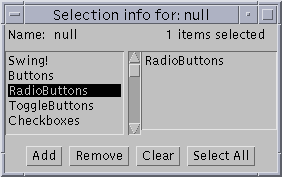

Like a monkey, Monkey "swings" through the component trees in a particular JavaTM Virtual Machine and presents the hierarchy in two different ways. The first is the actual Component hierarchy and the second is the hierarchy viewed as Accessible objects. In addition, if the user clicks the right mouse button over a tree node in Monkey, Monkey will present the user with a popup menu containing options for manipulating the object.
To run Monkey you need to have obtained and installed the JDK 1.1.5 or better, and the Java Foundation Classes.

After you follow these instructions, you should be ready to run Monkey. If you did not set up your CLASSPATH correctly you might get one of the following errors when running a Java application:Modify your CLASSPATH environment variable so that the jaccess.jar file that comes with this kit is included in the path. Modify your CLASSPATH environment variable so that the examples/Monkey and examples/AccessibilityPanels directories that come with this kit are included in the path. Modify your $JDKHOME/lib/awt.properties file (e.g., jdk1.1.5/lib/awt.properties or C:\jdk1.1.5\lib\awt.properties) to include the following lines (a sample awt.properties can be found here): AWT.EventQueueClass=com.sun.java.accessibility.util.EventQueueMonitor AWT.assistive_technologies=Monkey
Failed loading com.sun.java.accessibility.util.EventQueueMonitor: java.lang.ClassNotFoundException: com.sun.java.accessibility.util.EventQueueMonitor
Error trying to newInstance Monkey java.lang.ClassNotFoundException: MonkeyThe first error means that the jaccess.jar file is not in your CLASSPATH, and the second that the Monkey directory is not in your CLASSPATH.


Depending upon when it starts, the initial list displayed by Monkey
may not accurately reflect the current state of the Java Virtual Machine.
To update the display, select the "Refresh Trees" item in Monkey's "File"
menu.
 Copyright©
1995-97 Sun Microsystems, Inc. All Rights
Reserved.
To submit comments or suggestions about Java
Accessibility, please send mail to access@sun.com.
Copyright©
1995-97 Sun Microsystems, Inc. All Rights
Reserved.
To submit comments or suggestions about Java
Accessibility, please send mail to access@sun.com.
